LINKS
- Attack of the 50-Year-Old Comics
- Super-Team Family: The Lost Issues
- Mark Evanier's Blog
- Plaid Stallions
- Star Trek Fact Check
- The Suits of James Bond
- Wild About Harry (Houdini)
I recently unearthed this image in some corner of the internet and fell in love with it. I have no idea where it’s from, where it was taken or who’s in it, but I still love everything about it.
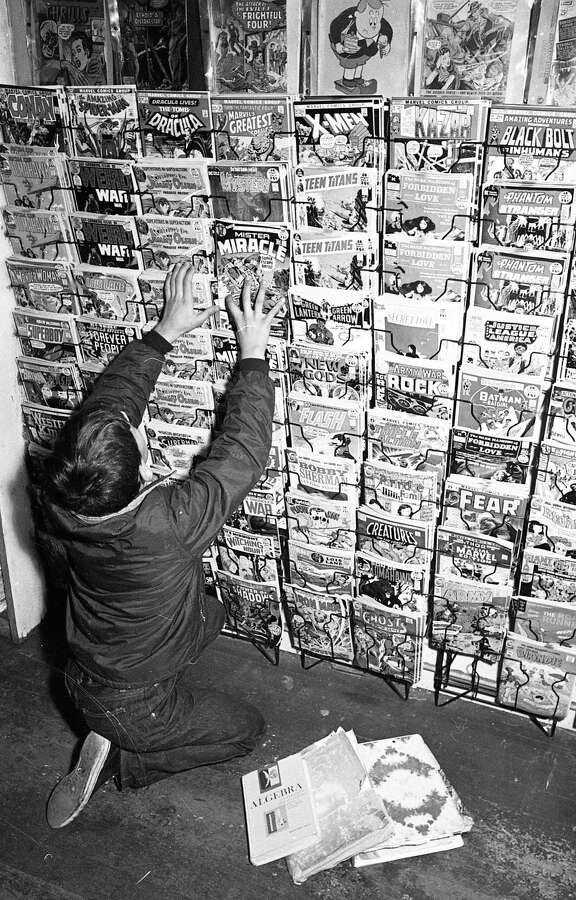
The first thing I noticed, naturally, was comic books, because there’s still enough kid in me to have the same reaction now as I’d have had when this picture was taken, which is to say pretty much the reaction this kid is having. But it’s the boy himself who makes the image work, resting on one knee with his hands raised as if in supplication (actually just trying to work a copy of Mister Miracle #6 out of the rack), his schoolbooks tossed aside carelessly as the lessons of the school day are pushed from his mind by the allure of boundless adventure.
And yet, is it maybe a little too perfect? Is it by sheer chance that the youngster’s pose just happens to suggest a religious experience? Is it merely a coincidence that the book he’s touching has “miracle” in the title? Is it dumb luck that his textbook is turned so we can easily read “Algebra” on the cover?
I don’t know and I don’t care. Logic suggests this may well have been staged, if for no other reason than that back when it was taken, everyone on Earth did not walk around with a camera in their pocket, ready to capture any random sight they found even mildly interesting. This image would have to have been taken with an old-fashioned, honest-to-gosh camera and developed and printed at some expense. People used to put a lot more thought into when to lug around a camera and when to click that shutter button; with at most 36 exposures on a film roll, they were selective about what they shot. How many people would really have thought, “Hey, there’s a kid looking at comics. Think I’ll take a picture”? Who would say, “Hey, Jimmy, let’s go to the store and I’ll take your picture looking at comics”? Maybe it was taken by a reporter to accompany an article on collecting. Or maybe, as I kind of prefer to believe, some dad took his son to the drug store to drop off his film, realized he still had an exposure left and figured, “What the heck?” Whatever the reason, I’m glad it exists.
With his face turned away, the kid remains anonymous and thus becomes universal: he could be me. Clinching the image’s appeal is the fact that the comics shown would’ve been more or less what was on the stands when I first discovered the world of four-color escapism, myself. Based on what I see, I would say the image dates to some time in the first two weeks of December, 1971, when I was six years old.
Then, as now, my eyes would first have been drawn to the artwork of Neal Adams, who accounts for a remarkably high number of covers here. In 1971, Adams was pretty much at his productive peak before largely abandoning comics for the world of advertising.
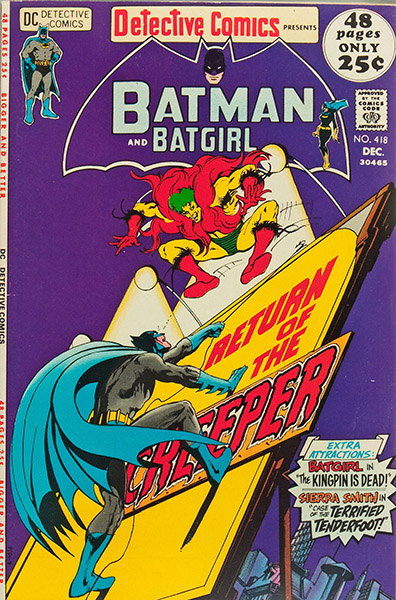
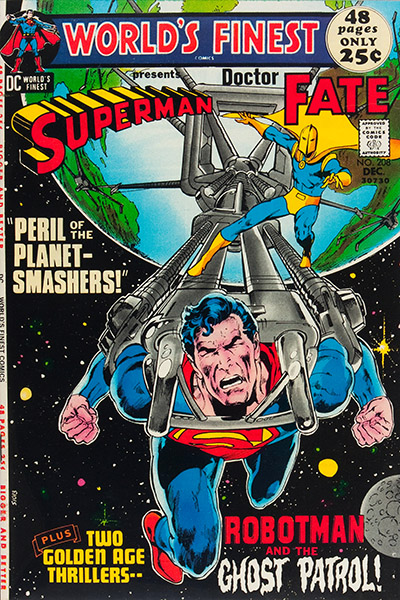

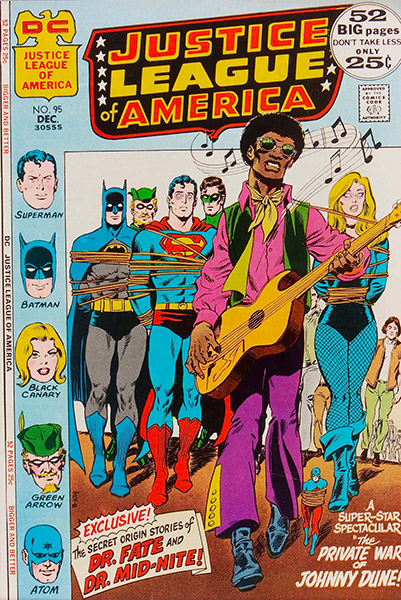
Three columns over from the boy’s right hand is Detective Comics #218, with Neal’s Batman startled by the bizarre anti-hero The Creeper. Much less visible on the extreme right edge of the frame is World’s Finest #208, with Superman moving the entire Earth using a set of giant chains as Dr Fate cheers him on. In all honesty, I can’t be 100% certain that is in fact the cover we’re seeing the edge of, but I couldn’t NOT include it as it’s (1) gloriously insane and (2) possibly the first comic I ever owned. Next up is Green Lantern/Green Arrow #87, featuring the debut of John Stewart, the African-American architect tapped to serve as Hal Jordan’s back-up defender of space sector 2814. Both cover and story are wonderfully drawn by Neal and inker Dick Giordano, but it won’t help as the series will still be cancelled in a couple of months. Finally, Justice League #95 wraps a perfectly serviceable Adams cover around a perfectly dreadful story, somewhat compensated for by the addition of reprints of the Golden Age origins of Dr Mid-Nite and Dr Fate.
Even when Adams isn’t involved, there are wonderfully colorful covers to choose from.
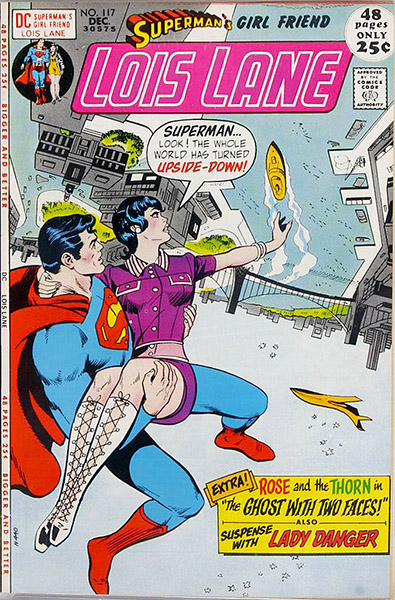
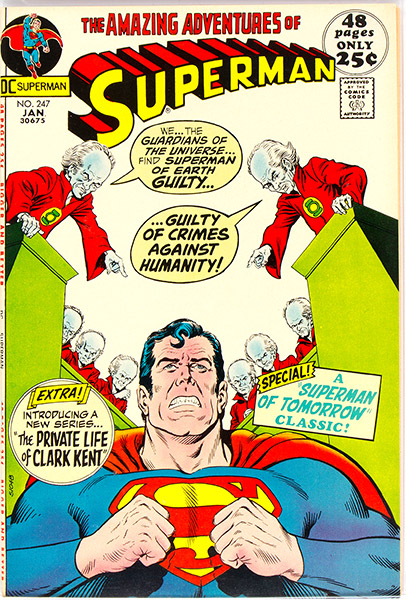
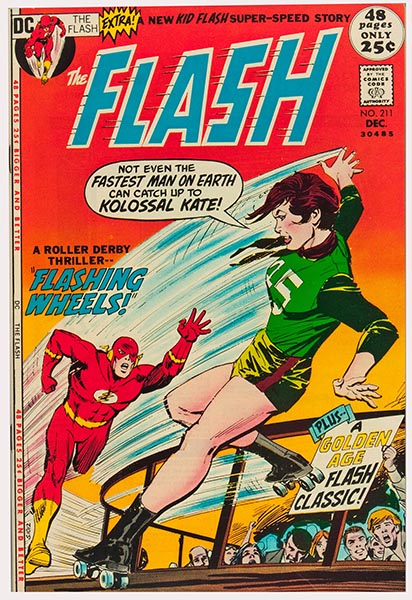

Still soldiering on past its 60’s heyday and with a title seemingly ill-suited to the era of Women’s Lib, Superman’s Girlfriend Lois Lane reaches its 117th issue with a story that involves a beleagured citizen of Earth’s dystopic future stuffing a desperate, handwritten plea for help into a bottle and setting it adrift. Miraculously a “freak bolt of lightning” transports the bottle back in time to the 20th century, where it just happens to float by Lois and Superman, out for romantic ride in a rowboat. Talk about luck! Travelling to the future, they free the social underclass (“downmen”) from the heartless rule of the upper class (“upmen”) by destroying the alien plants the upmen keep the downmen addicted to. Which — I guess? — is a metaphor for illicit drugs, and how the rich keep the poor hooked on them? Or something? Anyway I’m sure it’s wonderfully “relevant,” I’m just not sure to what.
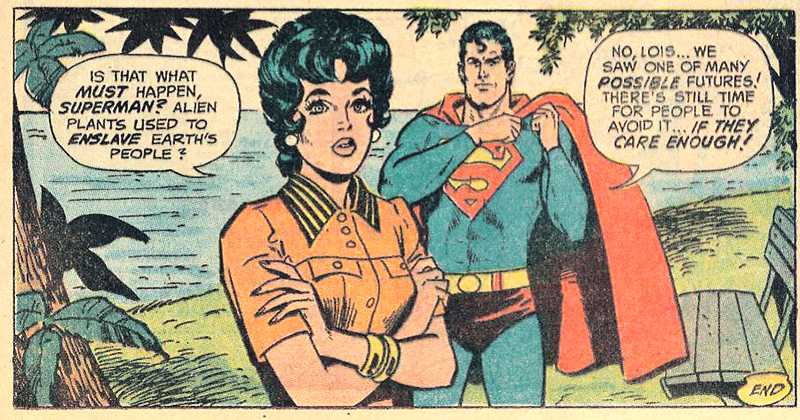
Meanwhile The Flash #218 settles for a more superficial appeal to current trends with a story that involves an alien doomsday device powered by the round-and-round motion of skaters at the Central City roller derby. Flash saves the Earth by skating at super-speed in the opposite direction. Would I kid you? And behind the dramatic Nick Cardy cover to Teen Titans #37 is a thoroughly depressing tale wherein our intrepid young heroes take on no less than the Four Horsemen of the Apocolypse, failing to prevent the demise of thousands of victims in a war-torn country as they lose every single battle with Death, Famine, War and Disease and teach young readers that existence is a tragic, fleeting thing ruled by cruel, indifferent fate and chance. Hey kids, comics!
Somewhat more celebrated is Superman #247, featuring Elliott Maggin’s famous story, “Must There Be A Superman,” wherein the Guardians of the Universe accuse Superman of arresting the development of Earth culture by solving too many of our problems for us. It’s a criticism he takes very much to heart, at least for as long as this story lasts. In the long term, it doesn’t have much of an effect on the series, but it does often show up on “Best Superman Stories” lists.
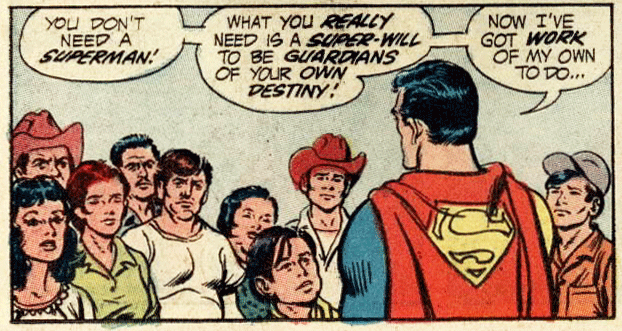
All of this adds up to a lot of DC Comics, which in the photo greatly outnumber Marvel titles. But who knows, it could just be that the racks extend well beyond the frame and there’s tons of unseen Marvels off to the right. Or maybe it just means the Marvel titles sold out faster than the DC books. At any rate, Marvel does claim the entire top row of the store display, and that’s probably not by accident.
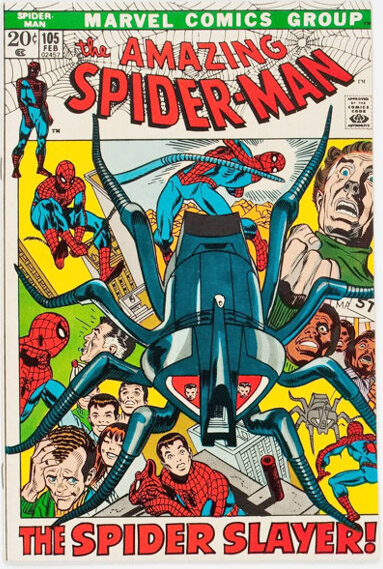

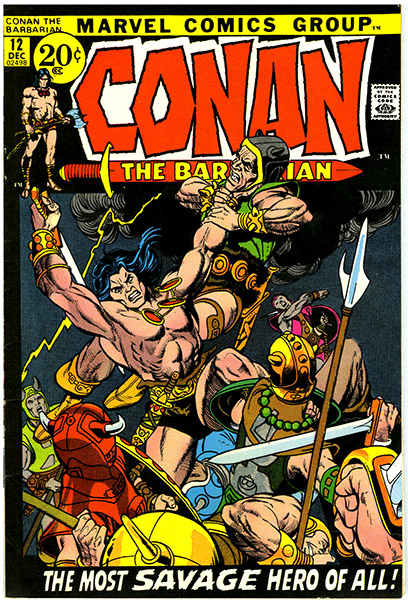
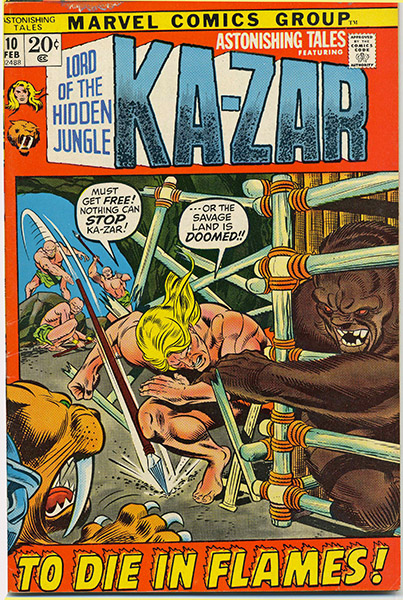
With The Amazing Spider-Man #105, Gil Kane is five issues into his tenure as the book’s new regular artist in a story that finds Daily Bugle editor J Jonah Jamison taking his second stab at funding a super-robot designed to end Spidey’s career. It goes about as well as you’d expect. Meanwhile, Amazing Adventures #10 spotlights Black Bolt and the Inhumans in what’s feeling like an extended try-out for their own book, though to be honest the Mike Sekowsky art probably isn’t helping their odds. In Sekowsky’s hands, the Inhumans take on an unintentionally (?) humorous look reminiscent of his Inferior Five, and it’s safe to say he gives us the least impressive take on Magneto, ever.
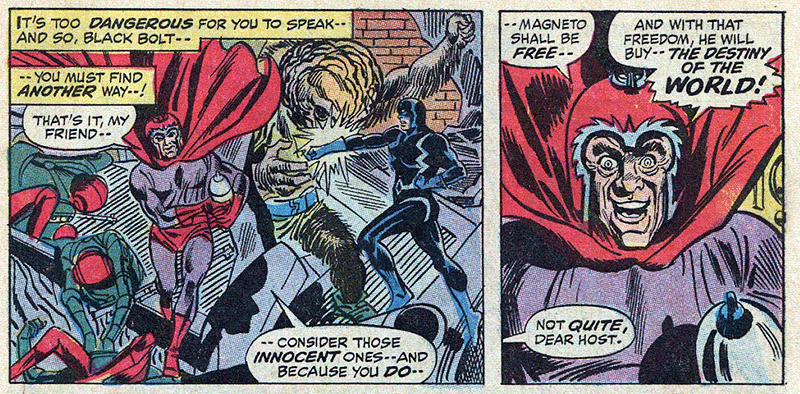
Conan The Barbarian #12 features everyone’s favorite Cimmerian warrior in a dramatic cover by veteran Gil Kane, while the interiors are drawn by up and coming fan favorite Barry Windsor Smith. Adapting the classic stories of pulp author Robert E Howard, Conan ends up as one of the more successful Bronze Age forays into new genres and kicks off a brief mini-craze of barbarian-themed titles (and later a couple of successful feature films starring Arnold Schwarzenegger).
Jumping onto that barbarian bandwagon is Astonishing Tales #10, featuring Ka-Zar, “Lord of the Hidden Jungle,” a character very much in the Edgar Rice Burroughs tradition of jungle lords and lost civilizations. In fact, Ka-Zar’s roots go back all the way to the earliest days of Marvel and further into the age of Pulps, but he and his trusty saber-tooth cat sidekick will never quite take off in comics on the order of Conan.
Curiously, King Size Iron Man #2 is shoved all the way down to the bottom row of the rack, in front of the kid’s right knee. Or maybe it’s not so curious, given what an awful book Iron Man was for most of its run.
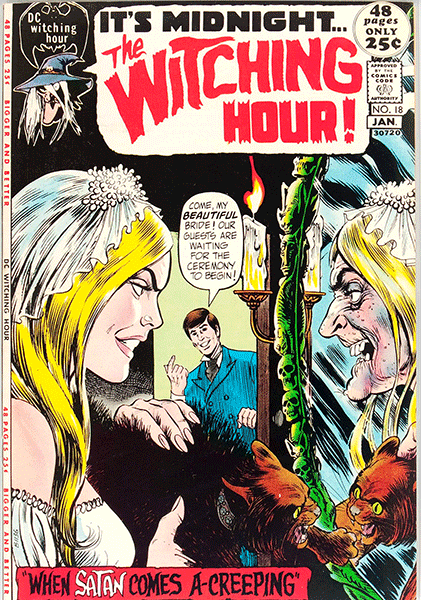
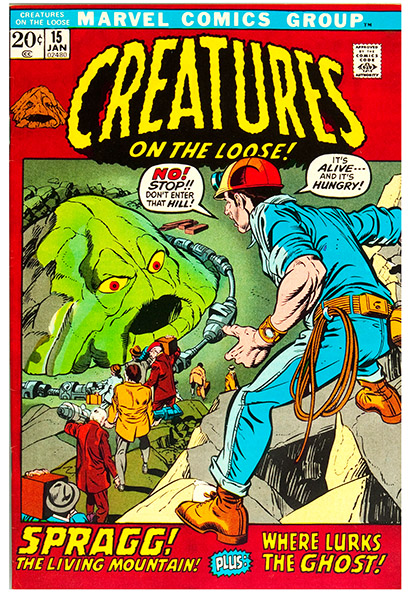
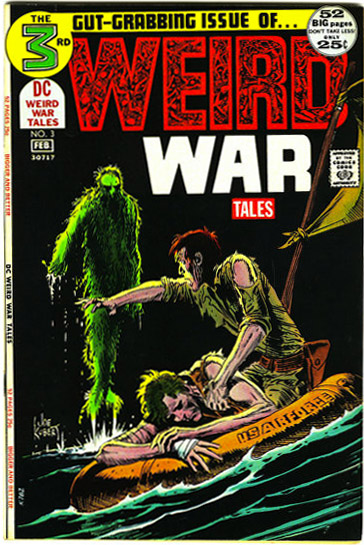
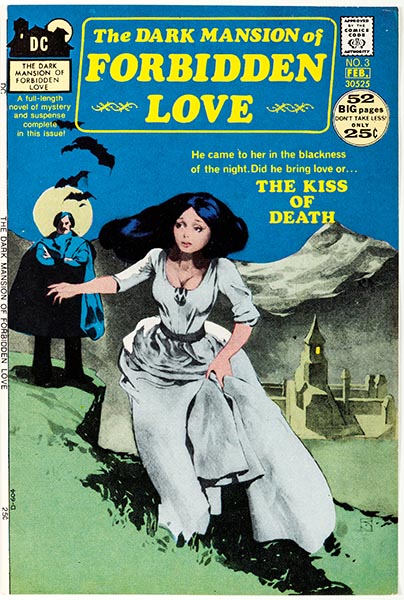
Another obvious trend in the photo is the early 70s’ fascination with all things supernatural. There’s straight-up horror in the form of The House of Mystery, The Witching Hour, Fear and Creatures on the Loose, but also various fusions of horror with other genres.
Towards the upper right of the photo, Weird War #3 continues DC’s experiment in blending the horror and war genres, in retrospect perhaps a logical union powering a title that will endure for another twelve years, ending in 1983 with issue #124. Meanwhile The Dark Mansion of Forbidden Love #3 marries horror to romance in the tradition of “gothic romance” novels and TV’s former ratings powerhouse, Dark Shadows. But alas, that show had in fact reached the end of its run the previous April, and the fact that issue #3 of Dark Mansion is sitting not so far from a bin of still-unsold copies of issue #2 suggests the gothic romance fad is on the verge of sputtering out. Indeed, with issue #4 the book will be retitled Forbidden Tales of Dark Mansion and the focus will shift away from romance and more towards straight-up horror. Still, it takes time to react to market forces, so here in December 1971 we can still spot a Dark Mansion doppleganger in the form of Sinister House of Secret Love, which as titles go is about as close to outright cloning as it gets.
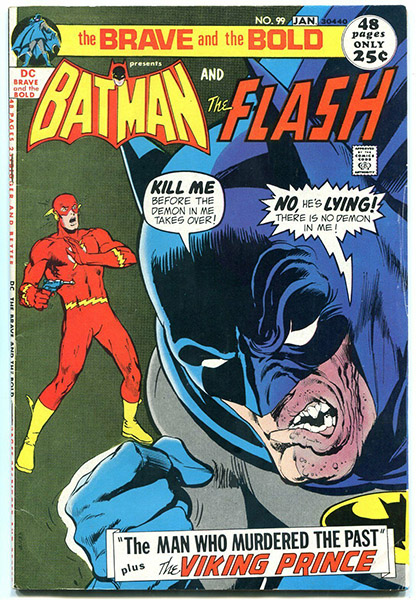

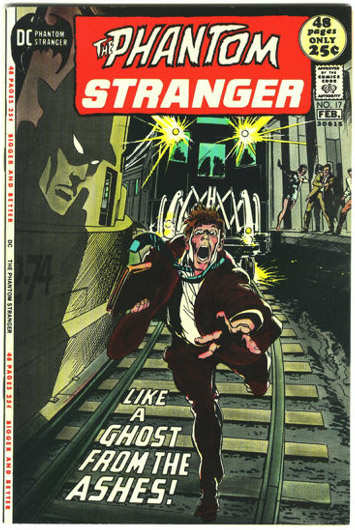
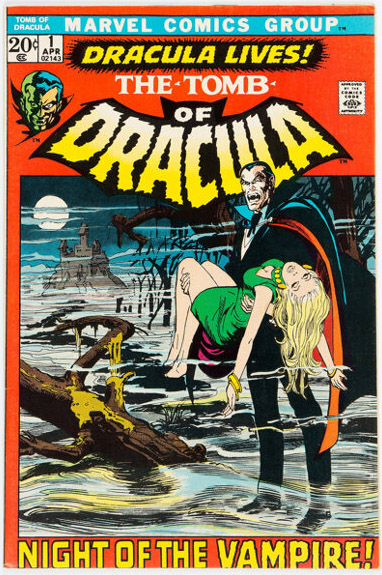
Horror even creeps into superhero territory with Brave and the Bold #99, featuring a team-up between Batman and The Flash (and another Adams cover!). In the story, Batman is compelled to return to a beach house owned by his late parents and ends up possessed by the ghost of a peg-legged pirate who guides him to a secret laboratory where Batman’s father once conducted experiments that, if successful, would breach the barrier between this world and the next. Surprisingly, Batman is totally on board with resuming these experiments and being off-and-on possessed by a pirate’s ghost if it means he’ll ultimately get to see his parents again.
At one point, Batman opens a safe to view the urn containing the Wayne couple’s (apparently comingled) ashes and grieve. So yes, that means all those scenes of Batman brooding over the cemetery graves of Thomas and Martha Wayne in other tales are invalidated here, as we learn not only that they were cremated, but that Bruce keeps their combined remains tucked away in a wall safe at a beachfront vacation home well outside of Gotham. Okay…
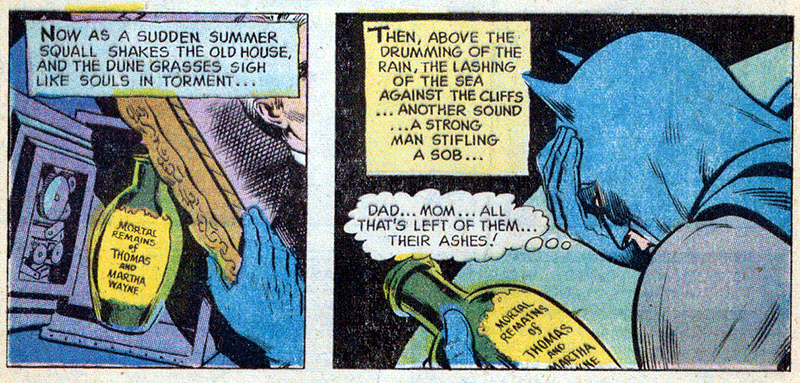
If you think this story sounds crazy, trust me, what I’ve shared is just the tip of the iceberg. Ultimately, the Flash convinces Batman to end his experiments before a legion of ghosts can possess thousands of living persons, even though it also means he’ll have to give up on ever being reunited with Mom and Dad. Nonetheless, the entire ordeal somehow manages to prove therapeutic, with a chipper Batman confiding at story’s end that his sad past is all behind him now; He no longer has any hang-ups over his parents’ deaths and his mind and soul are completely at peace. Therefore, this is the last Batman story that will ever be printed. Well no, but logically, shouldn’t it have been?
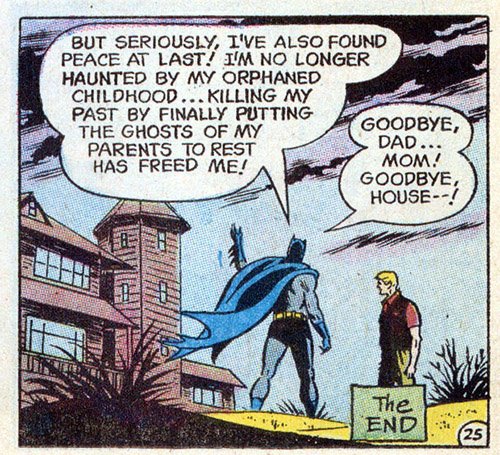
Not to be outdone, Superboy #180 finds the Teen of Steel influenced by a mysterious alien probe that crash lands on the Moon and sends a strange transmission to Earth, somehow exchanging Superboy’s Kryptonian powers for the instincts and abilities of a wolf, and the power to communicate with other wolves. By happy coincidence, a wolfpack has just appeared in Smallville for the first time since pioneer days, and they need a new leader, so Superboy is elected. Together they rid Smallville of the evil influence of a conniving warlock and reveal that wolves aren’t so bad, after all; they’re just misunderstood. “Wolves don’t cause evil,” Superboy explains. “They merely appear when evil is present, to seek it out and destroy it.” There you go, kids: bet they never taught you that in school. At story’s end, Superboy is wounded and near death but by yet another happy coincidence, the alien probe runs out of battery power, the transmission ends and our young hero is restored to his former super self, once again healthy and invulnerable. Whew.
Phantom Stranger #17 treads the middle ground between superheroics and horror, with a mysterious hero who seems to have whatever powers are necessary to move a story along, but is often content to take a back seat and just sort of let things unfold as they will. Despite membership in the Justice League, the Phantom Stranger is not your typical crime-fighter. And check it out, it’s another awesome Neal Adams cover.
And then of course we have the Lord of Vampires himself making his Marvel Comics debut in Tomb of Dracula #1, wherein some random nincompoop comes upon the skeletal remains of the Dark Lord and decides for no particular reason to pull the wooden stake from its chest, unleashing 70 straight issues of death and terror that will stretch to the end of the decade and spawn a spin-off black and white magazine. In a wall full of comics that today would all go for big, big bucks, TOD#1 is arguably the one you’d want to grab first as a time-traveling fortune hunter. And once again, Neal Adams provides the cover art. When did this guy sleep?
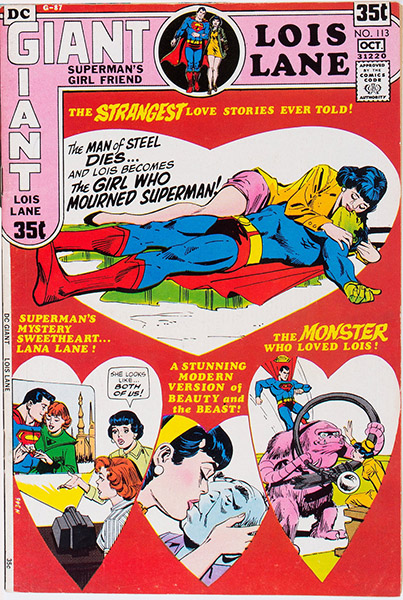
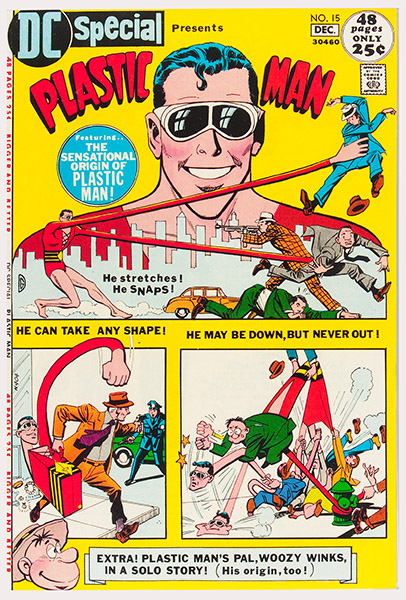
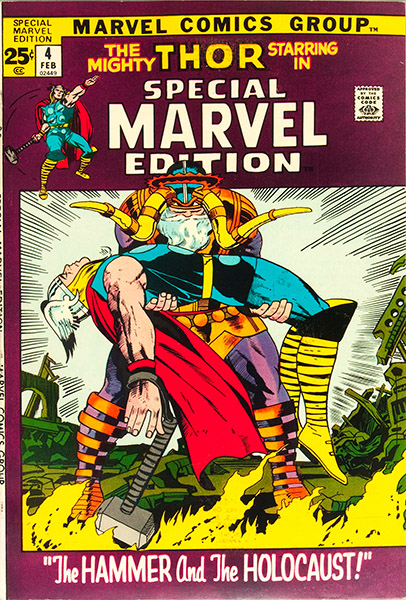
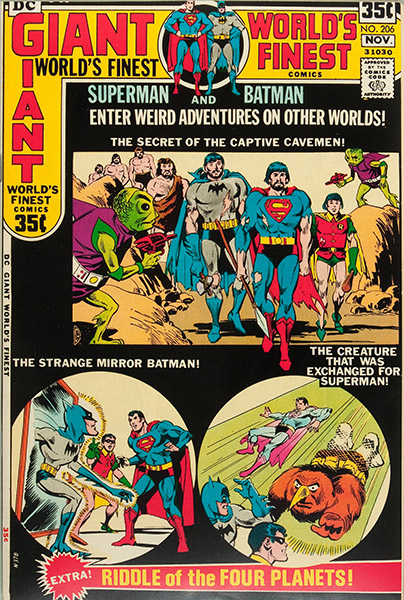
If there’s any trend bigger than horror in 1971, it’s reprints. By this point, retailers are starting to find comics more trouble than they’re worth for the few pennies they take in from sales, so to keep them loyal, DC is rolling the dice with a price hike from 15 to a whopping 25 cents across their line, compensating for the increase by raising the page count per issue from 36 to 52. And since they can’t just snap their fingers and come up with that much new content, that means padding out issues with reprints of old stuff. The Flash #218 includes a reprinted adventure of the Golden Age Flash, while Superman’s Pal Jimmy Olsen #145 includes a reprinted adventure of Golden Age kid group The Newsboy Legion. Meanwhile Lois Lane #113 and World’s Finest #206 interrupt their normal programming in favor of 52 pages of wall-to-wall reprints; nothing new at all beyond the cover art. They also feature a modified trade dress that makes them look like they belong to different series entirely, allowing them to remain on the racks even after newer issues have arrived. In fact, that World’s Finest issue has been on the rack since way back in August, while the Lois collection has been loitering since July.
As disappointing as reprints might have been for long-time readers, they could be a treasure trove for newer ones. Special Marvel Edition #4 presents classic tales of Thor which at this point were only a few years old but already super-hard to find in an era before eBay and comic shops. Meanwhile DC Special #15 introduced Bronze Age readers to one of the most popular characters of the Golden Age, the pliable palladin known as Plastic Man. This issue’s been on the shelf since September and it has the potential to stick around longer than any of them, since issue #16 won’t be published for another five years!
Though none are visible in the photo, DC has also at this point launched its fondly remembered “100-Page Super-Spectacular” format, nearly doubling the standard page count and pushing the price up to an astonishing 50 cents. Typically, only the lead story in each book is new, meaning the bulk of those 100 pages feature reprints from the Golden and Silver Ages, providing me and kids like me our first introduction to characters and concepts like the Justice Society of America, the Doom Patrol, the Sea Devils, Robotman, Blackhawk, Starman, The Seven Soldiers of Victory and the Boy Commandos.
Marvel’s response to DC is “hold my beer” as they launch several titles with the sole purpose of recycling old material, and that’s in addition to the frequent “surprise” reprints that popped up whenever a writer or artist missed a deadline for one of their “all new” titles (which was often).

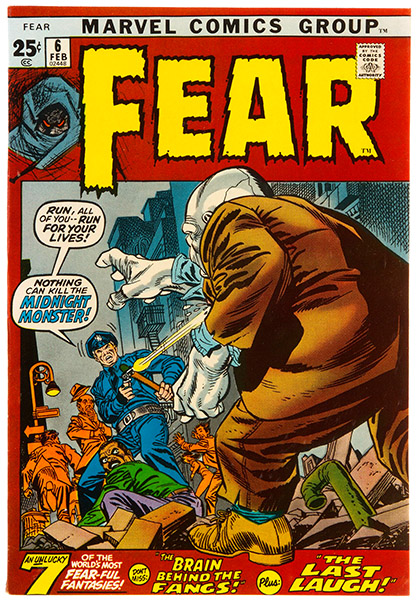
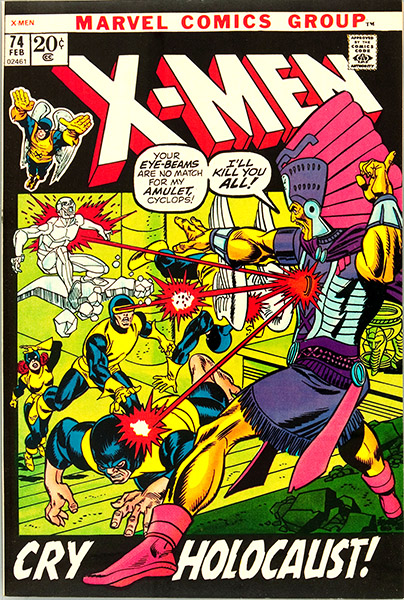

Marvel Triple Action #1 reprints Fantastic Four #55 from just five years earlier, but in fariness it’s a cracking epic wherein Dr Doom steals the Silver Surfer’s “power cosmic” and his surfboard, so it’s as deserving of a re-read as anything out there. Starting with issue #5, MTA will shift its focus to reprints of The Avengers and stay there for seven years until its 41st and final issue.
Fear #6 reprints monster stories by Jack Kirby and Steve Ditko dating as far back as the 1950s and the era that immediately preceeded the “Marvel Age” of superheroes. In about a year’s time, the title will morph beyond its reprint roots to feature new tales of Man-Thing and later Morbius, The Living Vampire, but for now it’s all about alien invaders, behemoths awakened from millenia of slumber and giant reptiles and insects wreaking havoc on Eisenhower-era America. Meanwhile, Western Kid #2 ventures even further into cultural irrelevance, reprinting 1950s cowboy tales in the age of moonshots and psychedelic rock. There’ll be another three issues of fightin’ and shootin’ before it’s carted off to Boot Hill.
Still, some sort of prize needs to go The X-Men, shown here seven issues into an amazing 26-issue odyssey of zombie-like purgatory that, as far as I know, has no parallel in comics history. Cannibalizing itself since issue #67 by running reprints of earlier issues, the title will become the Shrodinger’s Cat of the comics world, neither completely cancelled nor technically “in production” until 1975, when issue #94 finally breaks the reprint cycle and re-imagines the team with a new line-up destined for superstar status on newsstands and later on cinema screens. Our young Algebra-spurning comic fan is in the presence of issue #74, reprinting the contents of issue #26 (Nov, 1966).
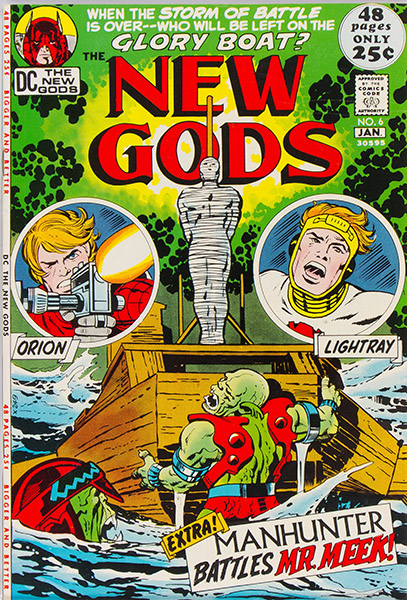
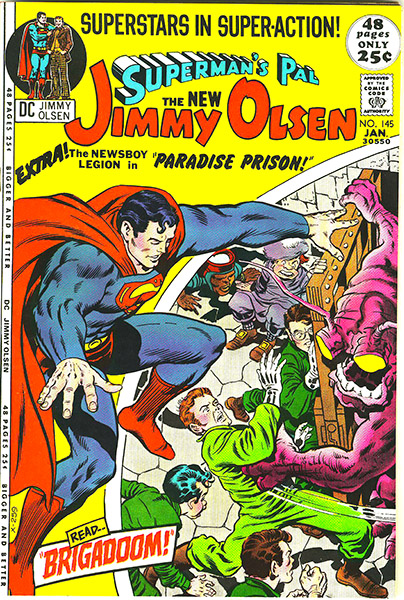

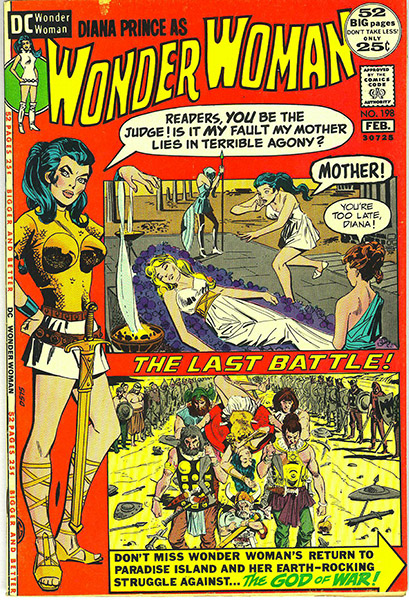
Not everyone is looking backwards, though. Several creators are casting about for new and fresh approaches to comics, but for the most part, they’re not having a lot of luck. A year after his dramatic move from Marvel to DC, Jack Kirby’s “Fourth World” titles aren’t really taking off as expected. With New Gods #6, and Forever People #6, we are already past the halfway point in both runs, each destined to end at #11. The Mister Miracle series, which holds such interest for our young friend, will hang on a bit longer to achieve an 18th issue. Logically the easiest “sell” in Kirby’s Fourth World line up should be his version of Superman’s Pal, Jimmy Olsen, but given that there’s enough unsold copies of issue #145 to fill five rack bins in the photo, I’ve got a bad feeling…
Originally featuring the adventures of a Revolutionary War-era frontiermsan, Tomahawk was a huge seller for DC in the days when Daniel Boone and Davy Crockett ruled the airwaves, but at this point the old guy’s near the end of the trail, his series having shifted suddenly forward in time to spotlight the adventures of his grown son in the days of the Wild West, while Tomahawk himself is a grizzled old coot still wearing his coonskin cap and puffing on a corn cob pipe like Mammy Yokum. The book has even been retitled Son Of Tomahawk, and given that “Mom” is a Native American, we’re able to add some timely “relevance” to the mix to deal with themes of racism. Tomahawk gets the axe after two more issues.
Meanwhile someone’s decided the key to reversing Wonder Woman‘s flagging sales is to remove her super-powers and turn her into an Emma Peel-like judo expert. Hey, we can’t all be geniuses. This issue, #198, features recycled panels from issues #183 and #184, rearranged in new configurations. Granted, they’re atypically interesting panels given that Diana is back on Paradise Island engaging in sword fights and Prince Valiant-style scenes of battling armies, but come on, the material reprinted here is barely two years old! Possibly writer/artist Mike Sekowsky was just too busy drawing goofy pictures of Magneto to meet his WW deadline for the month.
So that’s superheroes, romance and horror accounted for in that display rack. The “comic” part of “comic book” is less in evidence, but Charlton’s Blondie and Gold Key’s Road Runner let us know the humor genre is still around. Somewhere out of frame may lurk the likes of Harvey’s Richie Rich, Casper and Little Hot Stuff, and MLJ’s ever-popular line of Archie books. But as red-blooded post-kindergartners, we weren’t so interested in that stuff. What we did like, indeed my brother’s favorites, were war comics.


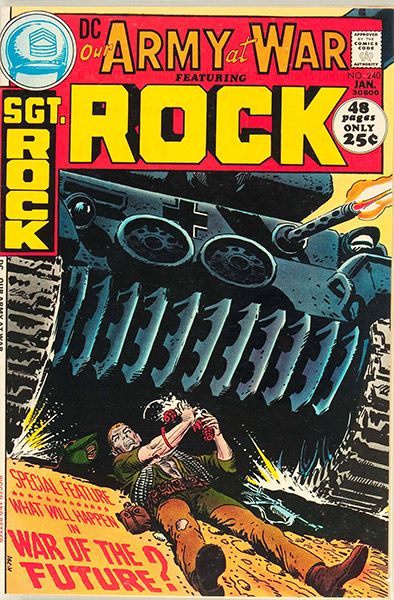

You might well wonder how companies selling war comics dealt with the divisive and demoralizing ordeal that was the Vietnam conflict. The answer was pretty simple; they ignored it, preferring instead to focus on World War II. Everyone could get behind the notion of taking down a few Nazis, and DC’s war-themed anthology titles eventually devoloped their own headlining “stars:” Our Fighting Forces had The Losers, Star-Spangled Comics had the Unknown Soldier, Our Army At War starred Sgt Rock (for whom the series would be renamed with issue #302) and G.I. Combat had The Haunted Tank. Even when stories strayed beyond the second world war, it was usually to peek in on the first World War, the Revolutionary War, the Civil War or even ancient wars, not the one currently in progress. Our Army At War #240, seen off to the right of our young shopper, even featured a back-up story set during a future war. And it was even drawn by…you guessed it…Neal Adams.
With the exception of a couple of stragglers from late summer, all the above issues arrived on newsstands between September and November of 1971, which initially led me to place the time for this photo in late November. However, thanks to the “Newsstand” feature on Mike’s Amazing World of Comics, I realized I should push that estimate forward a bit to account for a few comics that didn’t show up until the first week of December. And all of them were from Charlton.

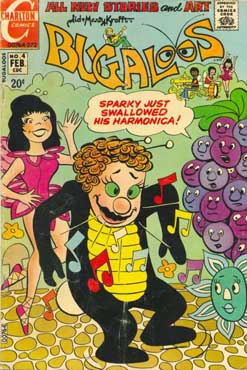
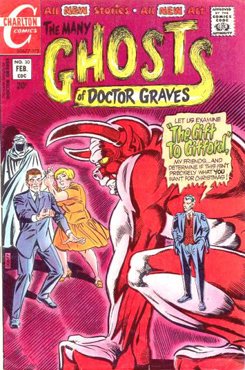
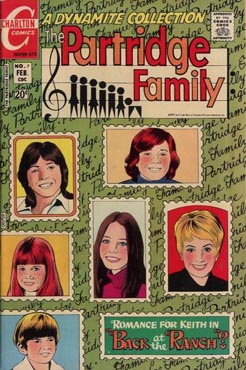
For the benefit of those who weren’t around at the time, Charlton Comics was the poor cousin to DC and Marvel, the publisher you meant when you said, “…and the rest.” (Marvel might have had them in mind when it talked about “Brand Ecch”). Charlton’s comics always felt cheaper and tackier than anyone else’s, printed paper that already seemed to have yellowed before the books ever made it to the shelf and wrapped with non-glossy covers that were course to the touch (and frequently the eye). Reportedly, they paid writers and artists less than any other publisher, too. Charlton’s line up in 1971 featured a few holdover horror titles that had been around for a while, like The Many Ghosts of Dr Graves; issue #30 featured a cover by former Marvel superstar Steve Ditko, who also contributed an 8-page story.
Otherwise, Charlton leaned heavily on movie and celebrity tie-ins, a sub-genre largely abandoned by the Big Two since the days when DC published comics devoted to guys like Jerry Lewis, Bob Hope and Pat Boone, and TV shows like Mr District Attorney and Big Town. Here in December of 1971, Charlton offers us issue #7 of The Partridge Family. In a month’s time, they’ll spin off that dreamy David Cassidy into his own title, but in the interim, we can all moon over Bobby Sherman. I confess I never quite understood, then or now, what it was Bobby Sherman was famous for other than looking cute, but I can attest that he was inescapable teen magazine fodder in my Elementary School days.
Rounding out the week’s releases is The Bugaloos #4, based on a bizarre Syd and Marty Krofft Show (sorry, is that redundant?) about teenage, British musicians in bug costumes being terrorized by Martha Raye. Or maybe they were actual singing insects with British accents. Or something. I don’t know, you figure it out. Anyway, let the superheros worry about Dr Doom and robots and ghosts, the Bugaloos have real problems: Sparky’s swallowed his harmonica!
So there you have it all in one picture: a visit to the newsstand in 1971, where your admission to a multiverse of superheroes, soldiers, ghouls and gods came at 25 cents a pop, and even a lowly reprint could transport you back in time on flights of fancy once taken by your dad’s generation. The photograph is both literally and figuratively a snapshot of a moment in time for a kid on his way home from school, for a comics industry trying to keep up with popular tastes, and for the owner of a store trying to clear a few cents per comic. In a week’s time, this display will have changed, and in a month’s time maybe completely, but on this one day in this one week of (probably) December of 1971, it tells a full story of fads and traditions on their way out, new concepts and characters just beginning their time in the sun and still others that would die aborning; here one day, gone the next. A moment lived and then forgotten, but lingering today, ghost-like, on a single frame of film.